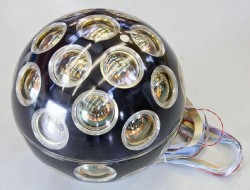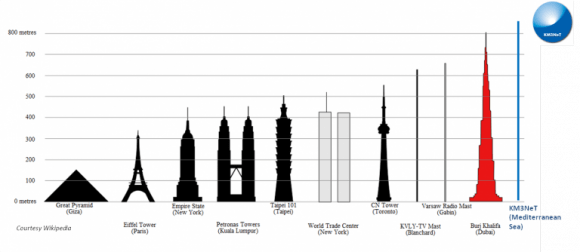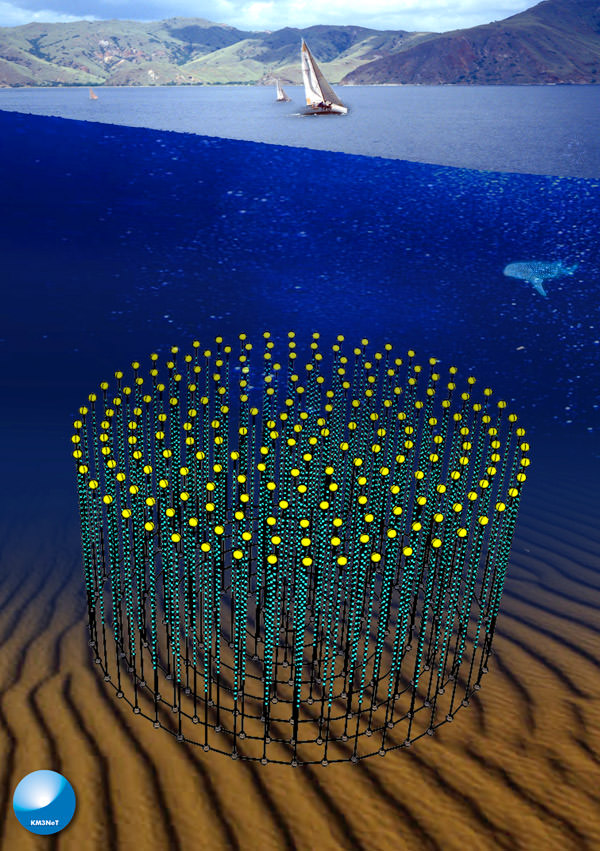[/caption]
The hunt for elusive neutrinos will soon get its largest and most powerful tool yet: the enormous KM3NeT telescope, currently under development by a consortium of 40 institutions from ten European countries. Once completed KM3NeT will be the second-largest structure ever made by humans, after the Great Wall of China, and taller than the Burj Khalifa in Dubai… but submerged beneath 3,200 feet of ocean!
KM3NeT – so named because it will encompass an area of several cubic kilometers – will be composed of lengths of cable holding optical modules on the ends of long arms. These modules will stare at the sea floor beneath the Mediterranean in an attempt to detect the impacts of neutrinos traveling down from deep space.
Successfully spotting neutrinos – subatomic particles that don’t interact with “normal” matter very much at all, nor have magnetic charges – will help researchers to determine which direction they originated from. That in turn will help them pinpoint distant sources of powerful radiation, like quasars and gamma-ray bursts. Only neutrinos could make it this far and this long after such events since they can pass basically unimpeded across vast cosmic distances.
“The only high energy particles that can come from very distant sources are neutrinos,” said Giorgio Riccobene, a physicist and staff researcher at the National Institute for Nuclear Physics. “So by looking at them, we can probe the far and violent universe.”

In effect, by looking down beneath the sea KM3NeT will allow scientists to peer outward into the Universe, deep into space as well as far back in time.
The optical modules dispersed along the KM3NeT array will be able to identify the light given off by muons when neutrinos pass into the sea floor. The entire structure would have thousands of the modules (which resemble large versions of the hovering training spheres used by Luke Skywalker in Star Wars.)
In addition to searching for neutrinos passing through Earth, KM3NeT will also look toward the galactic center and search for the presence of neutrinos there, which would help confirm the purported existence of dark matter.
Read more about the KM3NeT project here, and check out a detailed article on the telescope and neutrinos on Popsci.com.

Images property of KM3NeT Consortium


I like the project… I’m dissing the headline. This thing is a structure the same way that the US Highway system is a structure, and the way the Eurasian rail system is a structure… It is just foolishness to say the Great Wall of China is the only thing bigger. Even the GWoC is small and not massive compared to the above. KM3NeT will be GREAT, and produce incredible science. Why sully this with such a specious claim in the headline?
A definitional issue for sure. I haven’t really thought about it.
Intuitively, a structure should be structured in some manner to meet a need. The structure here allows for detectors to trace the direction of a muon light wake.
Road and rail systems are systems that grow organically to meet a need. Any overall structure (say, fractal coverage) is dependent on the contingent growth.
But maybe someone has a better idea?
Wow! Let’s do the neutrino oscillation. [/oscillates between flavors]
These detectors will be floating bubbles anchored to the seafloor, so its better to compare them to big ships, not big buildings.
“…encompass an area of several cubic kilometers…” should be “…enclose a volume of several cubic kilometers….” Otherwise this is a good article.
But this structure does not fully enclose the volume, it just has probes present in a large volume of free-flowing water. So encompass I think is the right word.
The term encompass means “to enclose within a circle”; therefore, since Jason M. is referring to “an area of several cubic kilometers” (i.e., volume), the term is correct in that context.
Thank you Ivan
This uses the sea water as a Cherenkov counter, where the neutrinos passing through the water emit radiation as they are moving faster than light in the water, c’ = c/n. I think we can do much the same with the Earth’s atomosphere. An array of heliostats which carry detectors can detect the scintillation produced by particles scattered by entering cosmic rays. We could then probe elementary particle physics up to 1000 TeV if we are good enough at collecting the data.
LC
Don’t mistake the bio-luminescence for first light… 🙂
so, let’s say there is a GRB and it showers the earth with the so-called superluminal neutrinos.
(or the garden variety for discussions sake)
will this, or any detector of it’s ilk, be able to derive a vector of source?
also, i wonder how they will be kept clean of algal growth. seems a bit deep for scuba divers with sponges.
“Successfully spotting neutrinos – subatomic particles that don’t interact with “normal” matter very much at all, nor have magnetic charges – will help researchers to determine which direction they originated from.”
Er… magnetic charges?
As far as I know, magnetic monopoles have never been observed. It seems bizarre to specifically go out of your way to say that neutrinos have no magnetic charge.
Don’t forget about IceCube – already built and already taking data at the South Pole for many years.